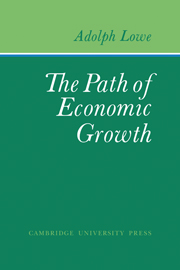Book contents
- Frontmatter
- Contents
- Preface
- Acknowledgments
- PART I The Basic Model
- PART II Changes in the Rate of Change
- 11 The Setting of the Problem
- 12 A Bird's-Eye View of an Expanding Traverse
- 13 On the Short-Period Variability of the Capital–Labor Ratio
- 14 Adjustment to a Higher Rate of Growth of Labor Supply in a Free Market. I. Structure Analysis
- 15 Adjustment to a Higher Rate of Growth of Labor Supply in a Free Market. II. Force Analysis
- 16 Adjustment to a Higher Rate of Growth of Labor Supply in a Collectivist System
- 17 Some Comments on the Role of Working Capital in the Traverse
- 18 Instrumental Analysis of Decline in the Rate of Growth of Labor Supply
- PART III Changes in the Rate of Change
- PART IV Changes in the Rate of Change
- Appendix: An Alternative Presentation of Lowe's Basic Model
- Glossary of Recurring Symbols
- Name Index
- Subject Index
17 - Some Comments on the Role of Working Capital in the Traverse
Published online by Cambridge University Press: 07 October 2011
- Frontmatter
- Contents
- Preface
- Acknowledgments
- PART I The Basic Model
- PART II Changes in the Rate of Change
- 11 The Setting of the Problem
- 12 A Bird's-Eye View of an Expanding Traverse
- 13 On the Short-Period Variability of the Capital–Labor Ratio
- 14 Adjustment to a Higher Rate of Growth of Labor Supply in a Free Market. I. Structure Analysis
- 15 Adjustment to a Higher Rate of Growth of Labor Supply in a Free Market. II. Force Analysis
- 16 Adjustment to a Higher Rate of Growth of Labor Supply in a Collectivist System
- 17 Some Comments on the Role of Working Capital in the Traverse
- 18 Instrumental Analysis of Decline in the Rate of Growth of Labor Supply
- PART III Changes in the Rate of Change
- PART IV Changes in the Rate of Change
- Appendix: An Alternative Presentation of Lowe's Basic Model
- Glossary of Recurring Symbols
- Name Index
- Subject Index
Summary
It was stated earlier that, with very few exceptions, the role of working capital in a stationary or dynamic structure of production has been neglected in modern literature. This is especially true of changes in a given stock of working capital and their integration with the overall process of adjustment to a higher rate of growth. We have briefly dealt with the problem in the context of our Bird's-Eye View of an Expanding Traverse, and shall now supplement these general comments by a schematic exposition of the step-by-step movements illustrated again in a numerical model. However, to facilitate understanding, we shall, first, discuss the salient points in literary terms.
Let us visualize the situation at the moment when expansion and, in particular, expansion of the initial stock of working capital is to begin. The influx of a new increment of labor supply and the concomitant appearance of additional savings have reduced the aggregate demand for consumer goods, displacing part of the labor force in Sector II and reducing demand for the output of Sector Ib, thus liberating part of the capital stock in Sector Ib for producing finished output other than secondary equipment. Assuming that a positive investment decision is forthcoming, this changed output in Sector Ib will henceforth consist of primary equipment, the embodiment of self-augmentation.
Now, this description in terms of sectoral aggregates is quite appropriate so long as our interest centers on the changes of finished output in the two equipment-good sectors – primary or secondary equipment.
- Type
- Chapter
- Information
- The Path of Economic Growth , pp. 176 - 181Publisher: Cambridge University PressPrint publication year: 1976



